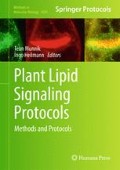Abstract
Detection of polyphosphoinositides (PPIs) is difficult due to their low chemical abundancy. This problem is further complicated by the fact that PPIs are present as various, distinct isomers, which are difficult, if not impossible, to separate by conventional thin layer chromatography (TLC) systems. PPIs in plants include PtdIns3P, PtdIns4P, PtdIns5P, PtdIns(3,5)P 2, and PtdIns(4,5)P 2. Here, a protocol is described analyzing plant PPIs using 32P-orthophosphorus pre-labeled material. After extraction, lipids are deacylated and the resulting glycerophosphoinositol polyphosphates (GroPInsPs) separated by HPLC using a strong anion-exchange column and a shallow salt gradient. Alternatively, PPIs are first separated by TLC, the lipids reisolated, deacylated, and the GroPInsPs then separated by HPLC.
Access this chapter
Tax calculation will be finalised at checkout
Purchases are for personal use only
References
Welti R, Li W, Li M, Sang Y, Biesiada H, Zhou HE, Rajashekar CB, Williams TD, Wang X (2002) Profiling membrane lipids in plant stress responses. Role of phospholipase D alpha in freezing-induced lipid changes in Arabidopsis. J Biol Chem 277:31994–32002
Welti R, Shah J, Li W, Li M, Chen J, Burke JJ, Fauconnier ML, Chapman K, Chye ML, Wang X (2007) Plant lipidomics: discerning biological function by profiling plant complex lipids using mass spectrometry. Front Biosci 12:2494–2506
Welti R, Wang X (2004) Lipid species profiling: a high-throughput approach to identify lipid compositional changes and determine the function of genes involved in lipid metabolism and signaling. Curr Opin Plant Biol 7:337–344
Munnik T, Nielsen E (2011) Green light for polyphosphoinositide signals in plants. Curr Opin Plant Biol 14:489–497
Munnik T, Irvine RF, Musgrave A (1994) Rapid turnover of phosphatidylinositol 3-phosphate in the green alga Chlamydomonas eugametos: signs of a phosphatidylinositide 3-kinase signalling pathway in lower plants? Biochem J 298:269–273
Munnik T, Musgrave A, de Vrije T (1994) Rapid turnover of polyphosphoinositides in carnation flower petals. Planta 193:89–98
Meijer HJG, Berrie CP, Iurisci C, Divecha N, Musgrave A, Munnik T (2001) Identification of a new polyphosphoinositide in plants, phosphatidylinositol 5-monophosphate (PtdIns5P), and its accumulation upon osmotic stress. Biochem J 360:491–498
Meijer HJG, Divecha N, van den Ende H, Musgrave A, Munnik T (1999) Hyperosmotic stress induces rapid synthesis of phosphatidyl-D-inositol 3,5-bisphosphate in plant cells. Planta 208:294–298
Meijer HJG, Munnik T (2003) Phospholipid-based signaling in plants. Annu Rev Plant Biol 54:265–306
Brearley CA, Hanke DE (1993) Pathway of synthesis of 3,4- and 4,5-phosphorylated phosphatidylinositols in the duckweed Spirodela polyrhiza L. Biochem J 290:145–150
den Hartog M, Musgrave A, Munnik T (2001) Nod factor-induced phosphatidic acid and diacylglycerol pyrophosphate formation: a role for phospholipase C and D in root hair deformation. Plant J 25:55–65
Latijnhouwers M, Munnik T, Govers F (2002) Phospholipase D in Phytophthora infestans and its role in zoospore encystment. Mol Plant Microbe Interact 15:939–946
Zonia L, Munnik T (2004) Osmotically induced cell swelling versus cell shrinking elicits specific changes in phospholipid signals in tobacco pollen tubes. Plant Physiol 134:813–823
Auger KR, Serunian LA, Cantley LC (1990) Seperation of novel polyphosphoinositides. In: Irvine RF (ed) Methods in inositide research. Raven, New York, pp 159–166
Clarke NG, Dawson RM (1981) Alkaline O leads to N-transacylation. A new method for the quantitative deacylation of phospholipids. Biochem J 195:301–306
Munnik T, de Vrije T, Irvine RF, Musgrave A (1996) Identification of diacylglycerol pyrophosphate as a novel metabolic product of phosphatidic acid during G-protein activation in plants. J Biol Chem 271:15708–15715
Stephens LR, Hughes KT, Irvine RF (1991) Pathway of phosphatidylinositol(3,4,5)-trisphosphate synthesis in activated neutrophils. Nature 351:33–39
Author information
Authors and Affiliations
Editor information
Editors and Affiliations
Rights and permissions
Copyright information
© 2013 Springer Science+Business Media, LLC
About this protocol
Cite this protocol
Munnik, T. (2013). Analysis of D3-,4-,5-Phosphorylated Phosphoinositides Using HPLC. In: Munnik, T., Heilmann, I. (eds) Plant Lipid Signaling Protocols. Methods in Molecular Biology, vol 1009. Humana, Totowa, NJ. https://doi.org/10.1007/978-1-62703-401-2_2
Download citation
DOI: https://doi.org/10.1007/978-1-62703-401-2_2
Published:
Publisher Name: Humana, Totowa, NJ
Print ISBN: 978-1-62703-400-5
Online ISBN: 978-1-62703-401-2
eBook Packages: Springer Protocols

